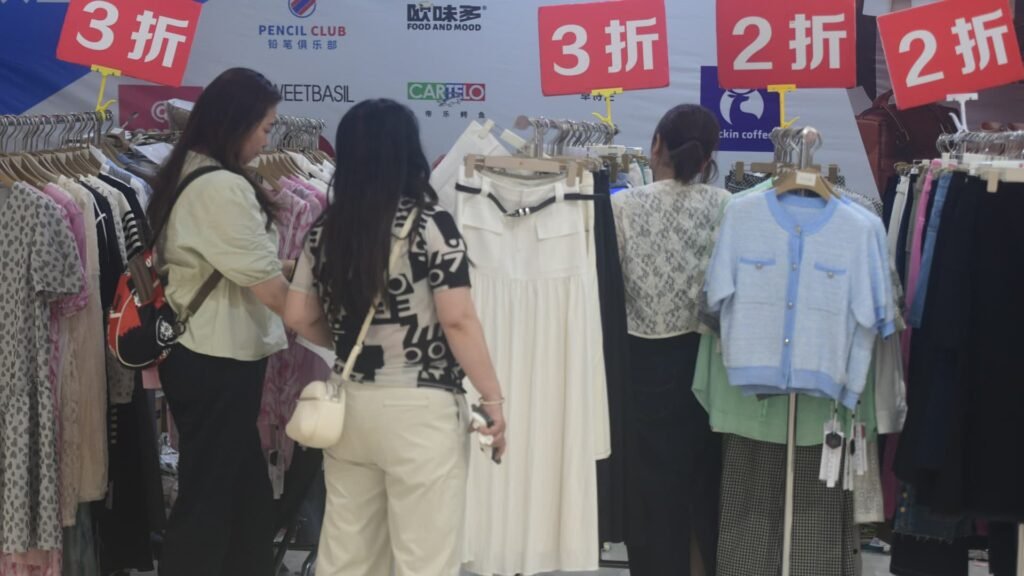Shoppers examine clothing promotions offering discounts of 80% and 70% at a supermarket in Hangzhou, Zhejiang province, China, on June 9, 2025.
Cfoto | Future Publishing | Getty Images
BEIJING — Consumer spending in China shows few signs of improvement in the near future due to uncertainties surrounding wealth, shifting consumer preferences, and a lack of social safety nets.
There have been four consecutive months of falling consumer prices, consumer confidence remains around historical lows, and the real estate sector is struggling to rebound. Analysts consistently highlight one key issue: stagnant income levels.
Since the pandemic began in 2020, the growth rate of disposable income in China has decreased significantly, now growing at a mere 5% annually, according to Jeremy Stevens, an Asia economist at Standard Bank.
Most sectors are not providing significant wage increases. Out of 16 sectors, only three—mining, utilities, and IT services—have shown wage growth that outpaces the GDP since 2020.
May’s business surveys indicated a contraction in the job market overall, particularly as factories adapt to U.S. tariffs. The unemployment rate for youth aged 16 to 24 and out of school remained high at 15.8% in April. Meanwhile, the official urban unemployment rate has been steady around 5%.

A record 64% of Chinese households reported in the third quarter of 2024 that they prefer saving over spending or investing, based on a survey from the People’s Bank of China.
This preference decreased slightly to 61.4% in the fourth quarter but has remained above 60% since late 2023.
Among those planning to spend more, the top categories included education, followed by healthcare and tourism, according to the PBOC’s March survey.
More than half of respondents perceived the job market as becoming tougher or uncertain.
Due to cultural tendencies towards saving and limited insurance coverage, individuals often bear the costs of healthcare, education, and retirement. The recent downturn in the real estate market has also affected spending, as property represents a significant portion of household wealth in China.
Luo Zhiheng, chief economist at Yuekai Securities, suggested increasing pension payouts significantly and enhancing public holiday offerings and consumption vouchers as potential measures to encourage spending.
Recently, Chinese authorities have intensified efforts to support employment and improve social services. However, they have largely avoided the mass cash payments that were issued in the U.S. and Hong Kong to stimulate post-pandemic spending.
Analysts warned of a slow recovery in retail sales in China, as major uncertainties for consumers persist.
Before the pandemic, “Chinese consumers readily embraced new products, even those that weren’t particularly groundbreaking,” noted Bruno Lannes, a senior partner at Bain & Company. “Today, they are more discerning and know exactly what they want,” he stated during a webinar on Thursday.
China will report its retail sales data for May on Monday, with analysts surveyed by Reuters forecasting a slowdown in growth to 4.9% year-on-year, down from 5.1% in April.
A trend away from big cities
Another reason for the decline in consumer prices is that Chinese shoppers are opting for more affordable products, benefiting from excess inventory of high-quality goods or moving to regions with lower living costs.
Shanghai lost 72,000 permanent residents last year, while Beijing’s population dropped by 26,000, according to a report by Worldpanel and Bain & Company. These cities are generally classified as “tier 1” cities in China.
Smaller cities categorized as “tier 3” and “tier 4,” however, have experienced significantly higher growth in the sales volume and value of daily essentials last year, which countered declines in tier 1 cities, as reported in the study covering packaged foods, beverages, personal care, and household products.
The research indicated that while the overall volume of such goods sold in China increased by 4.4% last year, average selling prices fell by 3.4% due to a preference for cheaper items and increased promotions by businesses.
This trend has also affected the flower market.
The Kunming International Flora Auction Trading Center, Asia’s largest flower market, reported in May a growing demand from lower-tier cities, leading to higher transaction volumes but lower average selling prices.
After the bustling May holidays, business has slowed, with flower seller Li Shenghuan noting that prices have slightly decreased as more people cultivate flowers, forecasting a rise in demand around the National Day holiday in October.
To highlight the disparity, rural per capita disposable income has consistently been less than half that of urban areas, according to official data. Last year, urban per capita disposable income stood at 54,188 yuan ($7,553), significantly lower than the U.S. figure of $64,474 reported in December.
Jeremy Stevens from Standard Bank highlighted that the consumption-to-income ratio in rural areas has “significantly increased” and has surpassed pre-pandemic levels, while that of urban households has fallen. However, he noted that lower-income households lack the wealth of higher-income groups, hindering significant increases in consumption in the short term.
The top 20% of earners account for half of China’s total income and consumption and 60% of total savings, according to Stevens. “Support policies for low-income groups, while well-intentioned, fall short without structural wage reform,” he explained.
Additionally, China’s “common prosperity” initiatives have led to institutional adjustments and policy changes that, although well-meaning, have contributed to ongoing uncertainty, Stevens observed, noting that these changes have not yet established a new balance.



